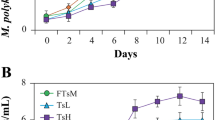Abstract
The red macroalga Pyropia/Porphyra is one of the most important marine crops in the world; Pyropia cultivation is severely affected by the green macroalga Ulva spp., a fouling organism. In this study, growth competition and acquisition of dissolved inorganic carbon (Ci) by Ulva prolifera and Pyropia yezoensis were investigated to understand the physiological characteristics of the two species. Competition experimental results showed that the relative growth rate of U. prolifera was not affected, whereas the growth rate of P. yezoensis was significantly inhibited. U. prolifera exhibited a competitive advantage when these two species were cultured together. The two algal species displayed high pH compensation points, suggesting that U. prolifera and P. yezoensis can photosynthesize by using HCO3 −; the utilization ability of U. prolifera is stronger than that of P. yezoensis. The net photosynthetic rates of P. yezoensis and U. prolifera were significantly inhibited by the carbonic anhydrase (CA) inhibitors acetazolamide and 6-ethoxyzolamide indicating that CA is implicated in carbon-concentrating mechanisms (CCM). 4,4′-diisothiocyano-stilbene-2,2′-disulfonate (DIDS), another inhibitor that prevents direct HCO3 − uptake, did not significantly affect U. prolifera. Conversely, DIDS can sharply decrease the photosynthetic rate of P. yezoensis, particularly at high pH. U. prolifera and P. yezoensis also showed CO2-limited photosynthesis by which the half-saturating concentration of Ci exceeds that of seawater. U. prolifera did not show active HCO3 − uptake; instead, U. prolifera used HCO3 − via extracellular CA for photosynthetic carbon fixation. U. prolifera also utilizes extracellular CA-mediated HCO3 − absorption to a higher extent than P. yezoensis. By contrast, P. yezoensis shows active HCO3 − uptake and extracellular CCMs for photosynthetic carbon fixation. Therefore, these two algal species can survive in changing environments with high pH and low Ci concentration because of the action of CCMs.





Similar content being viewed by others
References
Andría JR, Pérez-Llore’ns J, Vergara JJ (1999) Mechanisms of inorganic carbon acquisition in Gracilaria gaditana nom. prov. (Rhodophyta). Planta 208:561–573
Axelsson L (1988) Changes in pH as a measure of photosynthesis by marine macroalgae. Mar Biol 97:287–294
Beer S (1994) Mechanisms of inorganic carbon acquisition in marine maroalgae (with reference to the Chlorophyta). Prog Phycol Res 10:179–207
Beer S, Bjork M, Hellblom F, Axelsson L (2002) Inorganic carbon utilization in marine angiosperms (seagrasses). Funct Plant Biol 29:349–354
Drechsler Z, Sharkia R, Cabantchik ZI, Beer S (1993) Bicarbonate uptake in the marine macroalga Ulva sp. is inhibited by classical probes of anion exchange by red blood cells. Planta 191:34–40
Drechsler Z, Sharkia R, Cabantchik ZI, Beer S et al (1994) The relationship of arginine groups to photosynthetic HCO3 − uptake in Ulva sp. mediated by a putative anion exchanger. Planta 194:250–255
Duan W, Guo L, Sun D, Zhu S, Chen X, Zhu W, Xu T, Chen C (2012) Morphological and molecular characterization of free-floating and attached green macroalgae Ulva spp. in the Yellow Sea of China. J Appl Phycol 24:97–108
Gao K, Aruga Y, Asada K, Ishihara T, Akano T, Kiyohara M (1991) Enhanced growth of the red alga Porphyra yezoensis Ueda in high CO2 concentrations. J Appl Phycol 3:356–362
Giordano M, Beardall J, Raven JA (2005) CO2 concentrating mechanisms in algae: mechanisms, environmental modulation, and evolution. Annu Rev Plant Biol 56:99–131
Hellblom F, Beer S, Björk M, Axelsson L (2001) A buffer sensitive inorganic carbon utilization system in Zostera marina. Aquat Bot 69:55–62
Johnston AM (1991) The acquisition of inorganic carbon by marine macroalgae. Can J Bot 69:1123–1132
Johnston AM, Raven JA (1987) The C4-like characteristics of the intertidal macroalga Ascophyllum nodosum (L.) Le Jolis (Fucales, Phaeophyta). Phycologia 26:159–166
Johnston AM, Maberly SC, Raven JA (1992) The acquisition of inorganic carbon for four red macroalgae. Oecologia 92:317–326
Larsson C, Axelsson L (1999) Bicarbonate uptake and utilization in marine macroalgae. Eur J Phycol 34:79–86
Larsson C, Axelsson L, Ryberg H, Beer S (1997) Photosynthetic carbon utilization by Enteromorpha intestinalis (Chlorophyta) from a Swedish rock pool. Eur J Phycol 32:49–54
Lignell A, Pedersen M (1989) Effects of pH and inorganic carbon concentration on growth of Gracilaria secundata. Br Phycol J 24:83–89
Liu D, Keesing JK, Dong Z, Zhen Y, Di B, Shi Y, Fearns P, Shi P (2010) Recurrence of the world’s largest green-tide in 2009 in Yellow Sea, China: Porphyra yezoensis aquaculture rafts confirmed as nursery for macroalgal blooms. Mar Pollut Bull 60:1423–1432
Maberly SC (1990) Exogenous sources of inorganic carbon for photosynthesis by marine macroalgae. J Phycol 26:439–449
Matsuda Y, Hara T, Colman B (2001) Regulation of the induction of bicarbonate uptake by dissolved CO2 in the marine diatom, Phaeodactylum triconutum. Plant Cell Environ 24:611–620
Shen Q, Li H, Li Y, Wang Z, Liu J, Yang W (2012) Molecular identification of green algae from the rafts based infrastructure of Porphyra yezoensis. Mar Pollut Bull 64:2077–2082
Smith RG, Bidwell RGS (1989) Mechanism of photosynthetic carbon dioxide uptake by the red macroalga, Chondrus crispus. Plant Physiol 89:93–99
Starr R, Zeikus JA (1987) UTEX: the culture collection of algae at the University of Texas at Austin. J Phycol 23(Suppl):1–47
Sutherland JE, Lindstrom SC, Nelson WA, Brodie J, Lynch MDJ, Hwang MS, Choi H-G, Miyata M, Kikuchi N, Oliveira MC, Farr T, Neefus C, Mols-Mortensen A, Milstein D, Müller KM (2011) A new look at an ancient order: generic revision of the Bangiales (Rhodophyta). J Phycol 47:1131–1151
Zou D, Xia J, Yang Y (2004) Photosynthetic use of exogenous inorganic carbon in the agarophyte Gracilaria lemaneiformis. Aquaculture 237:421–431
Acknowledgments
This work was supported by the National Science and Technology Support Plan of China (Grant no. 2012BAC07B00), the Chinese National Natural Science Foundation (Grant No. 41476097), and the Technology Support-Social Development Projects managed by the Science and Technology Department of Jiangsu Province of China (Grant no. BE2011719).
Author information
Authors and Affiliations
Corresponding author
Rights and permissions
About this article
Cite this article
Li, X., Xu, J. & He, P. Comparative research on inorganic carbon acquisition by the macroalgae Ulva prolifera (Chlorophyta) and Pyropia yezoensis (Rhodophyta). J Appl Phycol 28, 491–497 (2016). https://doi.org/10.1007/s10811-015-0603-8
Received:
Revised:
Accepted:
Published:
Issue Date:
DOI: https://doi.org/10.1007/s10811-015-0603-8




